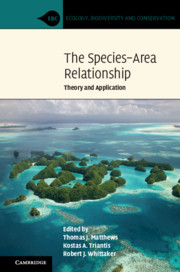Book contents
- The Species–Area Relationship
- Ecology, Biodiversity and Conservation
- The Species–Area Relationship
- Copyright page
- Contents
- Contributors
- Foreword
- Preface
- Part I Introduction and History
- 1 The Species–Area Relationship: Both General and Protean?
- 2 The History of the Species–Area Relationship
- Part II Diversity–Area Relationships: The Different Types and Underlying Factors
- Part III Theoretical Advances in Species–Area Relationship Research
- Part IV The Species–Area Relationship in Applied Ecology
- Part V Future Directions in Species–Area Relationship Research
- Index
- References
1 - The Species–Area Relationship: Both General and Protean?
from Part I - Introduction and History
Published online by Cambridge University Press: 11 March 2021
- The Species–Area Relationship
- Ecology, Biodiversity and Conservation
- The Species–Area Relationship
- Copyright page
- Contents
- Contributors
- Foreword
- Preface
- Part I Introduction and History
- 1 The Species–Area Relationship: Both General and Protean?
- 2 The History of the Species–Area Relationship
- Part II Diversity–Area Relationships: The Different Types and Underlying Factors
- Part III Theoretical Advances in Species–Area Relationship Research
- Part IV The Species–Area Relationship in Applied Ecology
- Part V Future Directions in Species–Area Relationship Research
- Index
- References
Summary
We briefly describe the species-area relationship (SAR) and summarize the different types, including the main dichotomy of island species–area relationship (ISAR) and species accumulation curves (SAC). We discuss the classification of the ISAR as a fundamental ecological law, despite its protean nature. Exploring this protean behaviour, we review the different ways in which ISAR form has been shown to vary between datasets. The final section outlines the structure of the book and provides a summary of the remaining chapters.
Keywords
- Type
- Chapter
- Information
- The Species–Area RelationshipTheory and Application, pp. 3 - 19Publisher: Cambridge University PressPrint publication year: 2021
References
- 7
- Cited by

